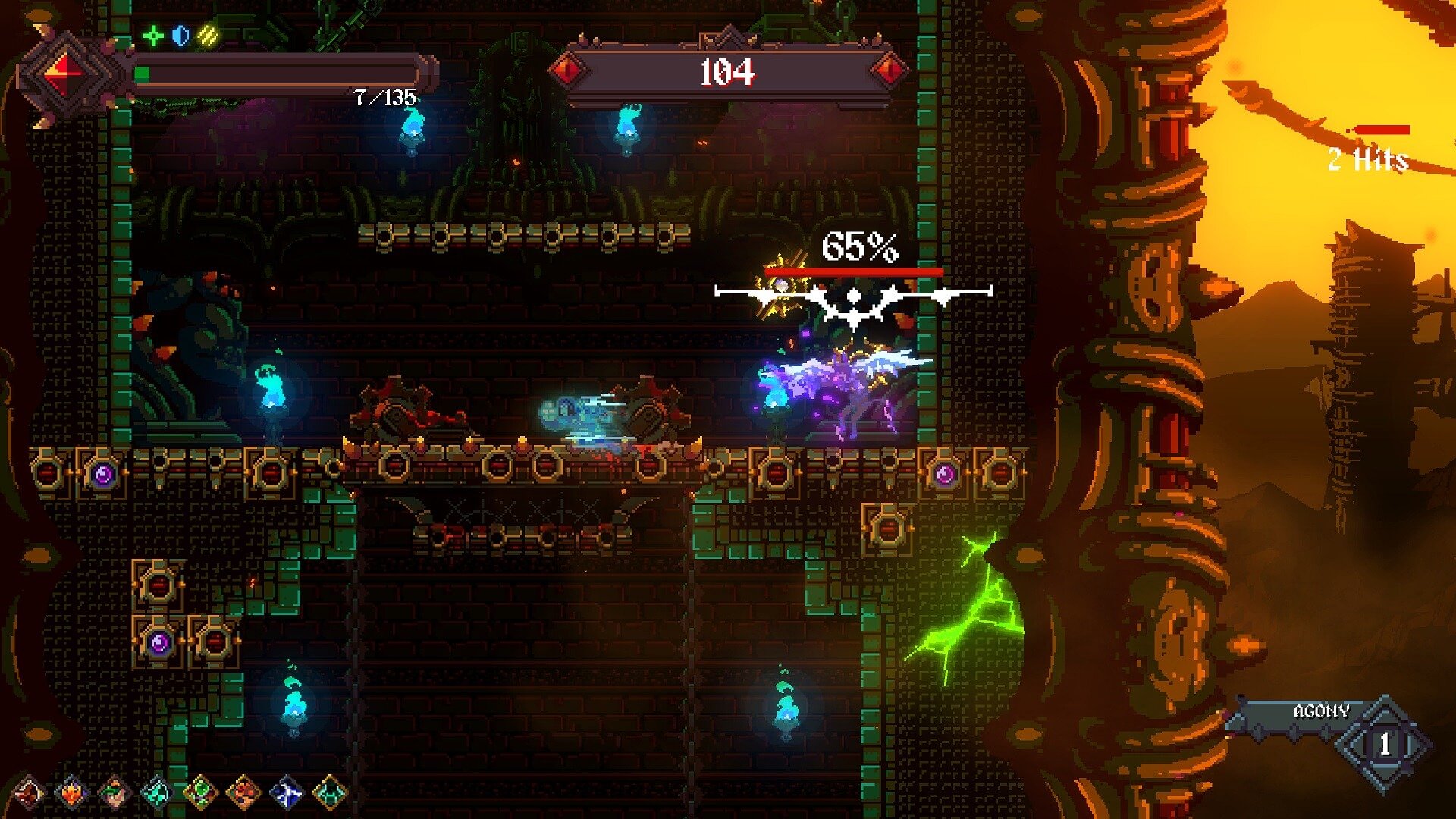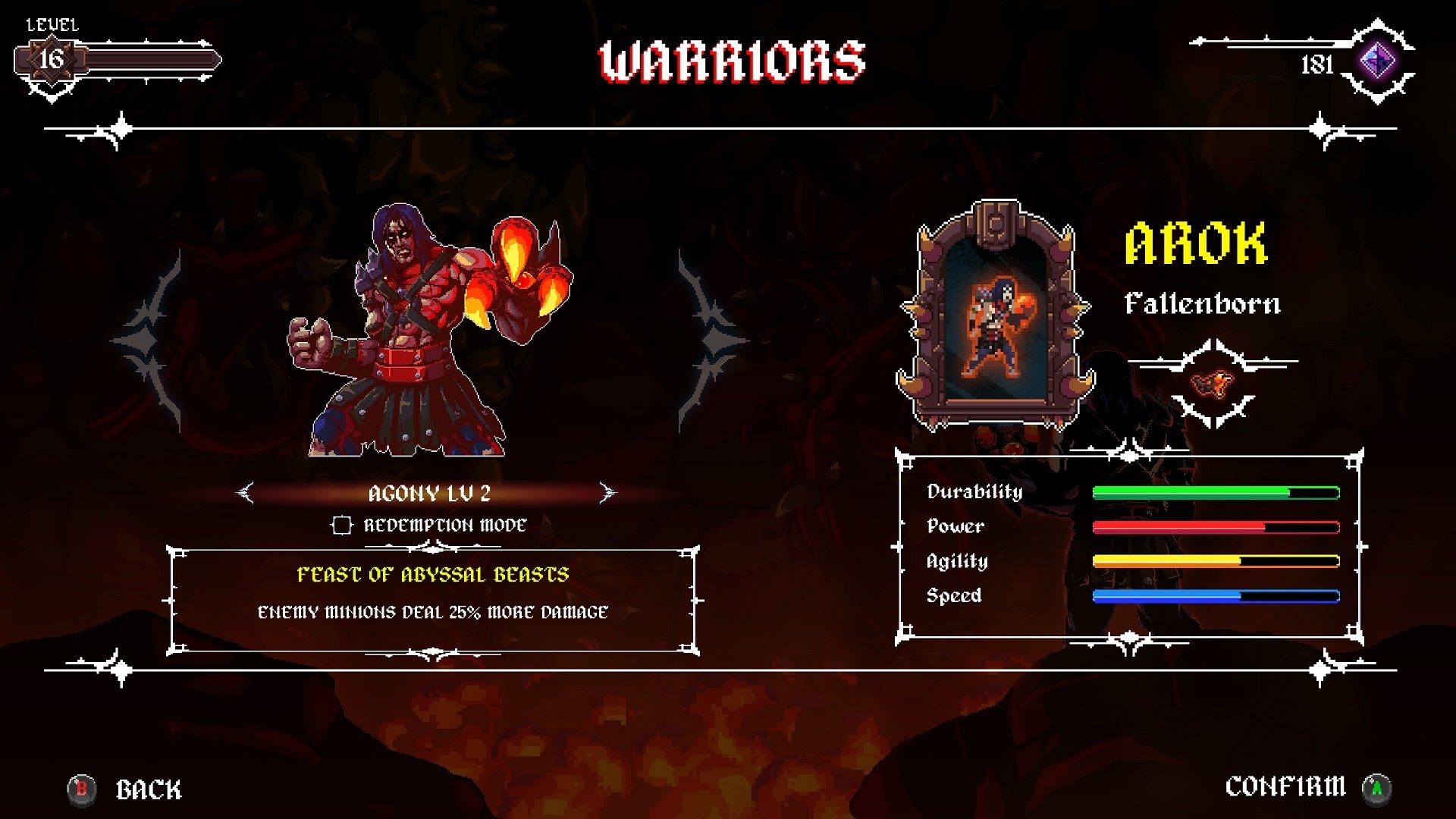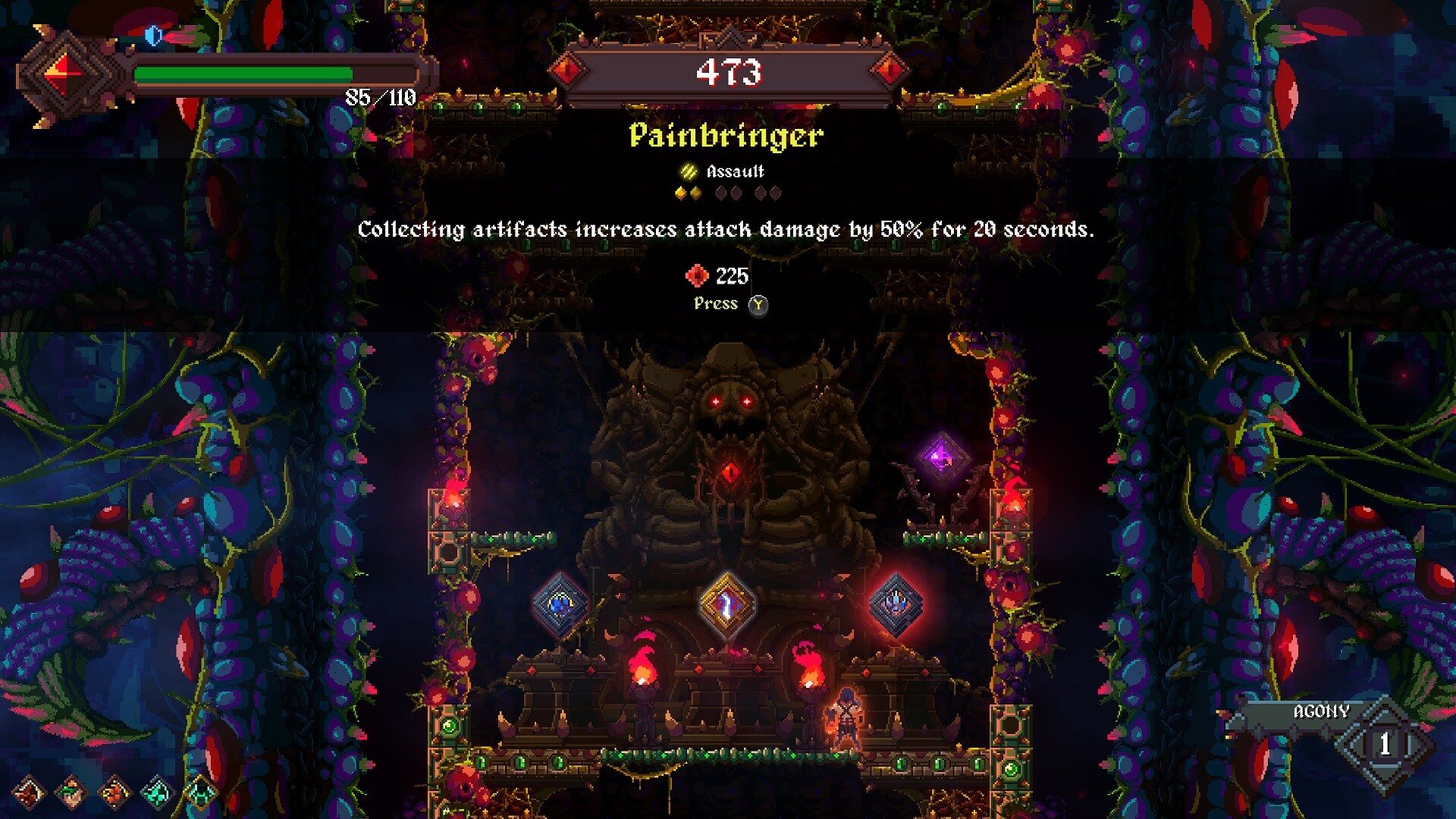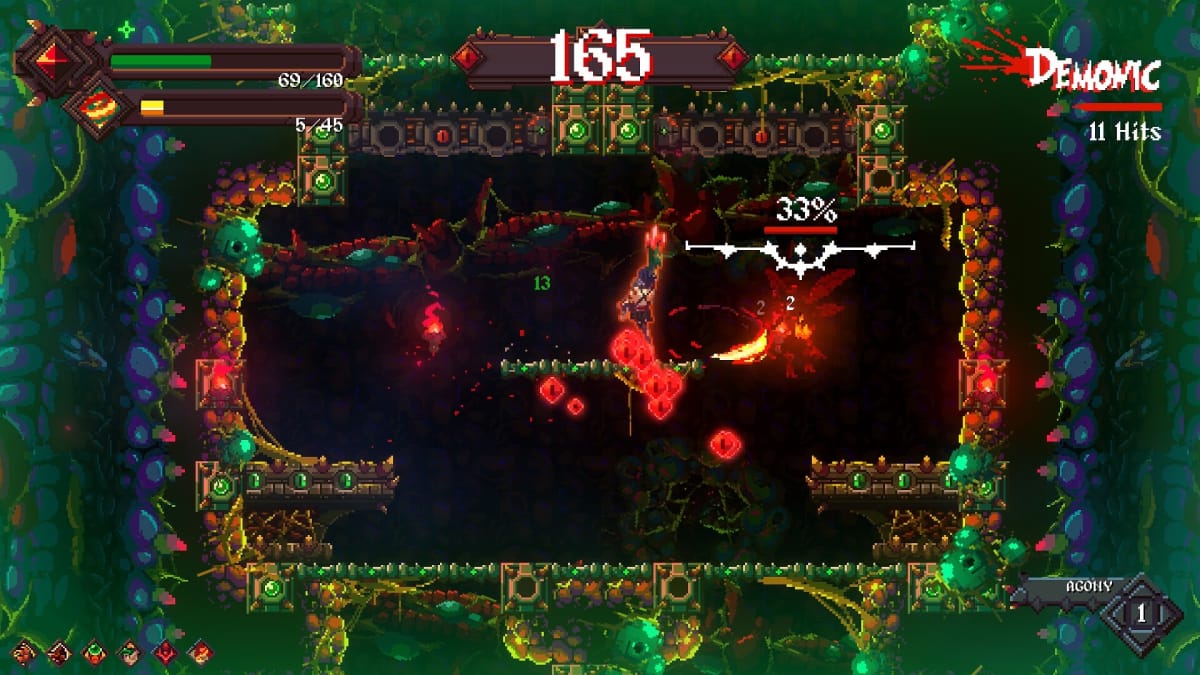After a year-and-a-half of Early Access, Rising Hell has reached 1.0, launching on Steam alongside PlayStation 4, Xbox One, and Nintendo Switch. This metal-infused vertical roguelite won't win awards for genre innovation, but it doesn't need to. Rather than attempting to shake up the formula, Tahoe Games hones in on the genre's strengths to provide a satisfyingly pure distillation of a bygone era.
Roguelike or Roguelite

Though referred to as a roguelite within this review, Rising Hell more accurately straddles the line between the two offshoots of the genre pioneered by Rogue. Roguelikes are characterized by procedural generation, intense difficulty, and serious consequences. If a player dies on the final boss, they need to start from square one. Roguelites, on the other hand, carry these elements while adding light progression systems that make them easier over time.
Rising Hell's progression system isn't as straightforward as something like Rogue Legacy, though. Players acquire blight during each run, which can be used to purchase characters and relics. Experience is also accrued, with a 40-tiered system awarding either blight, a talent, or a relic at each level. This feeds into its ingenious design. Rather than making the experience outright easier through permanently increasing player stats, Rising Hell encourages players through additional gameplay options and modifiers. The two unlockable characters main ranged weapons as opposed to Arok's physical claws, for example. This doesn't make the game easier, though, as they come with their own downsides. Zelos and Sydna, the unlockable characters, are more fragile. Their smaller health pools make utilizing the integral Hellbreak mechanic a riskier proposition. Their projectiles also aren't as versatile in the heat of the moment. They feel compromised as they can only fire directly left or right, mixing poorly with the generally constrained rooms and the characters' smaller health bars.
This mantra of a personalized playstyle extends to talents, passive upgrades purchased within each run, and relics, modifiers that can be attached at the beginning of each run. Sin Desolator is one such relic. With it equipped, enemies have 30% less health at the expense of removing artifact monsters, benign creatures that drop devastating special weapons.
Every player has different strengths, weaknesses, and playstyle preferences. Instead of throwing brute force at the issue, Rising Hell is designed to incrementally comfort players. As they're coming to grips with the gameplay loop, advanced techniques, and boss patterns, they'll come to ascertain which relics or characters suit them best. It's unique in that its progression system is simultaneously front and center while obfuscated behind this layer of individuality. While some relics seem better on the surface, they're not permanent stat upgrades. Players wanting to experiment with the utility of other relics will need to sacrifice especially useful ones to do so as only one relic can be equipped per run.
Getting Started With Rising Hell

With that said, what is Rising Hell's moment-to-moment gameplay loop? As its vertical roguelite description suggests, it tasks players with ascending through a series of procedurally generated levels. Each of the three worlds are comprised of several levels with a final boss encounter after beating world three's boss.
The moveset consists of a single attack button, jump button, and teleport. This simplistic basis is transformed through the Hellbreak mechanic. By default, Hellbreak is activated automatically when meeting the condition, though it can be turned off, requiring an additional button press. Hellbreak is a devastating one-hit special with invincibility frames activated by jumping underneath an enemy. This becomes integral to surviving. Chaining Hellbreaks makes quick work of enemies, with its invincibility frames becoming a high-level exploit. It's not just about performing it--when to do so and positioning within the scene are equally vital pieces of the puzzle. The teleport is another useful tool for avoiding damage, with its wide-ranging utility adding an additional layer to the proceedings.
The right positioning out of a teleport activates Hellbreak. With an infinite amount of teleports, Rising Hell begins to come into its own. There's a gratifying ebb and flow to mastering a sweet spot between running through levels quickly, killing as many enemies as possible, meanwhile taking as little damage as you can.
For any struggling players, there is a gauntlet mode that acts as a series of skill checks. Each challenge in Gauntlet focuses on a specific aspect of the game. Hellrisen tasks players with rising through a level by chaining Hellbreaks, with a fall resulting in instant failure. Madhell is structured like a standard level, with the added pressure of instadeath along with an abnormal number of traps. The list of challenges goes on, but each ratchets the difficulty up to 11 with the intent on training specific skills. They're decent distractions that can offer an intense challenge even for skilled players, but the main Conquest mode is the meat of the experience.
Rising Hell's only befuddling design decision is more of a double-edged sword than a true flaw. Its procedural generation feels static. While mid-world bosses are occasionally swapped and the order in which levels appear changes, the levels themselves feel virtually identical upon every playthrough. Many wave-based rooms and level-opening rooms are re-used ad nauseam. Even within the more procedurally generated environments, Rising Hell can't escape this aura of familiarity. The most random element comes from the talents. Every level is book-ended by an upgrade screen of sorts, letting players pick from one of three talents. Conversely, they can ignore them to save red souls. There's also the occasional Vault of Avarice or Trickster's Portal.
The lack of deviation can make repeat playthroughs a little repetitive, but it also makes success more attainable. With so many large stretches feeling identical to the last time, old-school memorization becomes a viable strategy. The genre's randomization is a barrier to entry for some, leading to anxiety over not knowing whether the next run will set them up or hinder them. Rising Hell uses procedural generation, but it's so calculated you wouldn't know it was there if you didn't already understand it was a roguelike/lite mainstay. Unfortunately, this scaled-back approach can feel like running through the motions. Skilled players needn't worry as each successful run unlocks an Agony level, Rising Hell's take on difficulty. Agony level two makes enemies deal 25% more damage, for example.
This added incentive is a more interesting way of challenging players than relying on poor luck, especially within this game's design. Because the game never becomes objectively easier in the way a game like Rogue Legacy does with its progression tree, there's always a goal to work toward. It'll keep dedicated players more invested through more reasonable means.
Rising Through Hell

Rising Hell is a great game for roguelike/lite fans, but newcomers should also consider keeping an eye on it. It caters to both audiences through de-emphasizing the genre's randomness. This may turn off hardcore players that love an intense challenge, but that's what the Agony levels exist for. The adrenaline-fueled metal soundtrack mixed with inspiration from classic sprite-based games is the cherry on top.
TechRaptor reviewed Rising Hell on Xbox Series X (Xbox One version in backwards compatibility) with a copy provided by the publisher/developer. The game is also available on PC, PlayStation 4, and Switch.
Review Summary
Pros
- Kickass Soundtrack
- Simple Mechanics Allow Depth
- The Hellbreak Mechanic
Cons
- Lacking in Enemy and Tile-Set Variety
Have a tip, or want to point out something we missed? Leave a Comment or e-mail us at tips@techraptor.net







